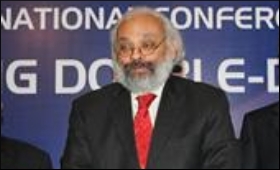|

|
'India to have world's 28% working population by 2020'
|
|

|
|
| Top Stories |
 |
|
|
|
SME Times News Bureau | 27 Mar, 2010
Subir Gokarn, Deputy Governor, Reserve Bank of India, speaking on demographic projections said that India would have upper edge compared to any other nation in terms of working population in coming years.
Gokarn, while delivering keynote address on 'People, Jobs and Productivity: 'The Simple' Dynamics of Inclusive Growth' at the Annual Regional Meeting & National Conference on "Achieving Double-Digit Growth" organized by the Confederation of Indian Industry (CII) – Western Region, said, "In the decade of 2010-20, India will add 120 million people in the working age-group looking for employment which will make India’s global working population at 28%. The nearest competitor China, on the other hand, will add only 19 million people in the same period contributing 5% of the global working population."
He further said, "Similarly, in 2020-30, India will add another 100 million people in the work force whereas, China by that time will see reduction by 62 million working age population in the same period. In India, the employment in service sector increased from 28% of total population in 1999-2000 to 30% in 2004-05. Similarly, the service sector contribution to GDP has increased from 55% of total GDP to 60% for the same period compared."
Gokarn added that the real output of manufacturing sector has increased by three times since 1993-94. He reiterated the strong need for training and skill development in order to capitalize on our high working age population.
The summit focused on outlining agendas that would be key enablers for India to achieve above 10% growth. It also deliberated upon the significance of inclusiveness and sustainability of this high growth.
Talking about the need of sustainable growth, Kirit Parikh, Former Member, Planning Commission at the summit said, "The coal-based energy production unit needs a committed supply of coal during its lifespan. However, we might not see any new units after 2035 as there would not be sufficient coal reserves for those units for their lifespan. Considering the present reserves, we will see the coal reserves exhausting in 30-35 years that is near 2045."
Naina Lal Kidwai, Group General Manager and Country Head, India, Hongkong and Shanghai Banking Corporation said, "Every organization now understands the importance of sustainable growth. Even IT companies are focusing on sustainable growth through meeting compliances, better servicing and building efficiency."
Chandrajit Banerjee, Director General, CII, also emphasized on the sustainable growth and development of the country. He said that there are many challenges particularly in the segment of ecological issues and the industry has to work together to maintain the right balance for the long term growth of the country.
Naushad Forbes, Chairman, CII Western Region and Director, Forbes Marshall Pvt. Ltd at the CII Summit said, "There are key issues which need to be addressed to ensure inclusive and sustainable growth including, skill development and reducing emission levels. If the country grows at 8.4% per annum for next 30 years, we will be a middle-income country and if we achieved 10.4% growth for the same period, we will be a developed nation like Korea."
Arun Nanda, Deputy Chairman – CII Western Region and Executive Director, Mahindra & Mahindra Ltd speaking at the panel discussion said, "One can live without electricity but not without water. At our new Mahindra Township we are going to recycle water from the sewage which would meet 50% of water requirement at the township. The cost will be around Rs 3 per kiloliter which is very cheap."
Ganesh Natarajan, Chairman, CII Task Force on Higher Education and Vice Chairman & CEO of Zensar Technologies Ltd at the Panel Discussion in Summit said, "Achieving double-digit growth for two years will not be sufficient but would be required for about 20 years to see the country as a developed nation. There are many opportunities in every parts of the country which are untapped but have potential skilled human resources. Focusing on these areas like the States of Jammu & Kashmir, North-East, and West Bengal etc would drive the country.
Hence, the double-digit growth rate would be outcome of these States’ development."
|
|
|
| |
|
|
|
|
|
|
|
|
|
|
|
|
|
|
| |
| Customs Exchange Rates |
| Currency |
Import |
Export |
US Dollar
|
84.35
|
82.60 |
UK Pound
|
106.35
|
102.90 |
Euro
|
92.50
|
89.35 |
| Japanese
Yen |
55.05 |
53.40 |
| As on 12 Oct, 2024 |
|
|
| Daily Poll |
 |
 |
| Do you think Indian businesses will be negatively affected by Trump's America First Policy? |
|
|
|
|
|
| Commented Stories |
 |
|
|
|
|
|
| |
|